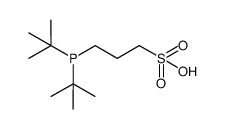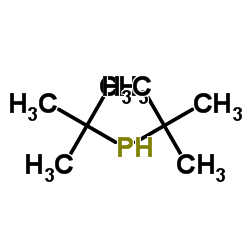3-(Di-tert-butylphosphino)propane-1-sulfonic acid
Modify Date: 2025-08-26 12:03:19

3-(Di-tert-butylphosphino)propane-1-sulfonic acid structure
|
Common Name | 3-(Di-tert-butylphosphino)propane-1-sulfonic acid | ||
|---|---|---|---|---|
| CAS Number | 1055888-89-5 | Molecular Weight | 268.35300 | |
| Density | N/A | Boiling Point | N/A | |
| Molecular Formula | C11H25O3PS | Melting Point | N/A | |
| MSDS | Chinese USA | Flash Point | N/A | |
| Name | dtbpps |
|---|---|
| Synonym | More Synonyms |
| Molecular Formula | C11H25O3PS |
|---|---|
| Molecular Weight | 268.35300 |
| Exact Mass | 268.12600 |
| PSA | 76.34000 |
| LogP | 4.42400 |
| InChIKey | JPNPRWMRUCIEMN-UHFFFAOYSA-N |
| SMILES | CC(C)(C)P(CCCS(=O)(=O)O)C(C)(C)C |
|
Section 1: Product Identification Chemical Name:Di-t-butyl(3-sulfonatopropyl)phosphine, min. 98% CAS Registry Number:1055888-89-5 Formula:(C4H9)2PCH2CH2CH2SO3H EINECS Number:none Chemical Family:organophosphine ligand Synonym:Bis(1,1-dimethylethyl)(-3-sulfonatopropyl)phosphane
Section 2: Composition and Information on Ingredients IngredientCAS NumberPercentACGIH (TWA)OSHA (PEL) Title compound1055888-89-5100%no datano data Section 3: Hazards Identification Emergency Overview:Irritating to skin, eyes and respiratory tract. Primary Routes of Exposure:Ingestion, inhalation, eyes Eye Contact:Causes slight to mild irritation of the eyes. Skin Contact:Causes slight to mild irritation of the skin. Inhalation:Irritating to the nose, mucous membranes and respiratory tract. Ingestion:No information available on the physiological effects of ingestion. May be harmful if swallowed. Acute Health Affects:Irritating to skin, eyes and respiratory tract. Chronic Health Affects:No information on long-term chronic effects. NTP:No IARC:No OSHA:No SECTION 4: First Aid Measures Immediately flush the eyes with copious amounts of water for at least 10-15 minutes. A victim may need Eye Exposure: assistance in keeping their eye lids open. Get immediate medical attention. Wash the affected area with water. Remove contaminated clothes if necessary. Seek medical assistance if Skin Exposure: irritation persists. Remove the victim to fresh air. Closely monitor the victim for signs of respiratory problems, such as difficulty Inhalation: in breathing, coughing, wheezing, or pain. In such cases seek immediate medical assistance. Seek medical attention immediately. Keep the victim calm. Give the victim water (only if conscious). Induce Ingestion: vomiting only if directed by medical personnel. SECTION 5: Fire Fighting Measures Flash Point:no data Autoignition Temperature:no data Explosion Limits:no data Extinguishing Medium:carbon dioxide, dry powder or foam If this product is involved in a fire, fire fighters should be equipped with a NIOSH approved positive pressure Special Fire Fighting Procedures: self-contained breathing apparatus and full protective clothing. Hazardous Combustion andIf involved in a fire this material may emit irritating fumes. Decomposion Products: Unusual Fire or Explosion Hazards: No unusual fire or explosion hazards. SECTION 6: Accidental Release Measures Spill and Leak Procedures:Small spills can be mixed with vermiculite or sodium carbonate and swept up. SECTION 7: Handling and Storage Store in a tightly sealed container under an inert atmosphere of nitrogen or argon. Keep in a cool, dry, Handling and Storage: well-ventilated place. SECTION 8: Exposure Controls and Personal Protection Eye Protection:Always wear approved safety glasses when handling a chemical substance in the laboratory. Skin Protection:Wear protective clothing and gloves. Ventilation:Handle the material in an efficient fume hood. If ventilation is not available a respirator should be worn. The use of respirators requires a Respirator Respirator: Protection Program to be in compliance with 29 CFR 1910.134. Ventilation:Handle the material in an efficient fume hood. Additional Protection:No additional protection required. SECTION 9: Physical and Chemical Properties Color and Form:white solid Molecular Weight:268.35 Melting Point:no data Boiling Point:no data Vapor Pressure:no data Specific Gravity:no data Odor:none Solubility in Water:insoluble SECTION 10: Stability and Reactivity Stability:moisture sensitive Hazardous Polymerization:no hazardous polymerization Conditions to Avoid:prolonged exposure to moisture Incompatibility:strong oxidizing agents Decomposition Products:carbon monoxide, carbon dioxide, sulfur dioxide, phosphorus oxides and organic fumes. SECTION 11: Toxicological Information RTECS Data:No information available in the RTECS files. Carcinogenic Effects:no data Mutagenic Effects:no data Tetratogenic Effects:no data SECTION 12: Ecological Information Ecological Information:No information available SECTION 13: Disposal Considerations Disposal:Dispose of according to local, state and federal regulations. SECTION 14: Transportation Shipping Name (CFR):Non-hazardous Hazard Class (CFR):NA Additional Hazard Class (CFR):NA Packaging Group (CFR):NA UN ID Number (CFR):NA Shipping Name (IATA):Non-hazardous Hazard Class (IATA):NA Additional Hazard Class (IATA):NA Packaging Group (IATA):NA UN ID Number (IATA):NA SECTION 15: Regulatory Information TSCA:Not listed in the TSCA inventory SARA (Title 313):Not regulated under SARA 313 Second Ingredient:none SECTION 16 - ADDITIONAL INFORMATION N/A |
|
~83% 
3-(Di-tert-buty... CAS#:1055888-89-5 |
| Literature: Nierth, Alexander; Kobitski, Andrei Yu; Ulrich Nienhaus; Jaeschke, Andres Journal of the American Chemical Society, 2010 , vol. 132, # 8 p. 2646 - 2654 |
| Precursor 2 | |
|---|---|
| DownStream 0 | |
| 3-(Di-tert-butylphosphino)propane-1-sulfonic acid |
| DI-T-BUTYL(3-SULFONATOPROPYL)PHOSPHINE |
| 3-(DI-TERT-BUTYLPHOSPHONIUM)PROPANE SULFONATE |
| 3-(Di-t-butylphosphonium)propane sulfonate |



